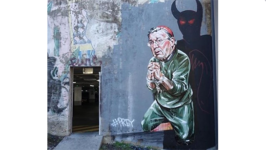The Offence of Graffiti in New South Wales

A mural depicting a satanic figure hovering over a kneeling, handcuffed George Pell in a prison tracksuit has been removed from privately-owned premises.
The mural, created by Australian artist Scott Marsh, was painted on property of owned by Wilson Parking – just 50 metres from the entrance of St Mary’s Cathedral College and less than 100 metres from the front door of Mr Pell’s former residence.
The complaint
A spokeswoman for the Archdiocese of Sydney confirmed it had contacted Wilson Parking to complain about the mural, and had been assured the company was already in the process of removing it.
Wilson Parking said its decision was due to complaints received from members of the public.
“We’re not seeking to make any kind of statement, religious or otherwise, but have simply acted upon complaints from members of the public who find the painting offensive,” a the company’s spokesperson told the media.
Political art
This is not the first time Mr Marsh’s politically-charged artwork has attracted controversy.
Nor is the first time he has sought to satirise George Pell, painting two other large scale murals of the disgraced former cardinal.
One of those murals, painted behind Botany View Hotel during the same-sex marriage debate, featured Mr Pell with his hand on a wedding-dress clad Tony Abbott’s crotch, captioned with “the happy ending”. That mural was later painted over.

When asked about his latest piece, Mr Marsh described it as “holding a mirror up to the hypocrisy of the church.”
“This is a global institution that for half a century at a minimum was molesting children and covering it up on an industrial scale,” he remarked. “Thousands of lives ruined in Australia alone.”
In March this year, Pell was sentenced to six years in jail for sexually abusing two Choirboys while he was the Catholic archbishop of Melbourne in the 1990s.
The offence of graffiti in NSW
Section 4 of the Graffiti Control Act 2008 (NSW) prescribes a maximum penalty of four penalty units, or $440, for intentionally marking any premises or property without the consent of the occupier or, where the premises is unoccupied, the person in charge.
The section makes clear that the offence does not apply to the marking of any public footpath or public pavement with chalk, including, but not limited to, marking out a hopscotch or handball court with chalk.
The maximum increases to 12 months in prison and/or a fine of 20 penalty units, or $2,200, where the offence is committed in ‘circumstances of aggravation’ – which means by the use of any ‘graffiti implement’ or in such a manner that the mark is not readily removable by wiping or using water or detergent.
A ‘graffiti implement’ is defined as spray paint, a marker pen, or any implement designed or modified to produce a mark that is not readily removable by wiping or by use of water or detergent.
‘Spray paint’ includes any liquid or other substance that is designed to stain, mark or corrode and to be applied from a spray can, and includes the spray can.
The offence of destroying or damaging property in NSW
Posting graffiti can also constitute an offence under section 195 of the Crimes Act 1900 (NSW), which prescribes a maximum penalty of 5 years in prison for any person who intentionally or recklessly destroys or damages property belonging to another.
Intentionally means wilfully or purposely, while recklessly means foreseeing the possibility of damage or destruction but proceeding regardless.
The courts have found that property is considered to have been damaged where:
- There is permanent damage,
- There is temporary functional derangement,
- There is temporary impairment of usefulness,
- The physical integrity of the property is altered, and
- The property is rendered imperfect or inoperative.
Examples of conduct found by the courts to constitute damage include:
- Painting graffiti on walls or floors,
- Placing a blanket in a toilet and flushing,
- Letting down the tyres of a car,
- Breaking a raw egg on the windscreen of a car, and
- Taking a cap from a person’s head and repeatedly stomping on it.
It has been held that temporarily blocking another from accessing property is not enough to establish the offence.
The maximum penalty increases to ten years in prison where the offence occurs ‘in company’, which means with another person or persons.







